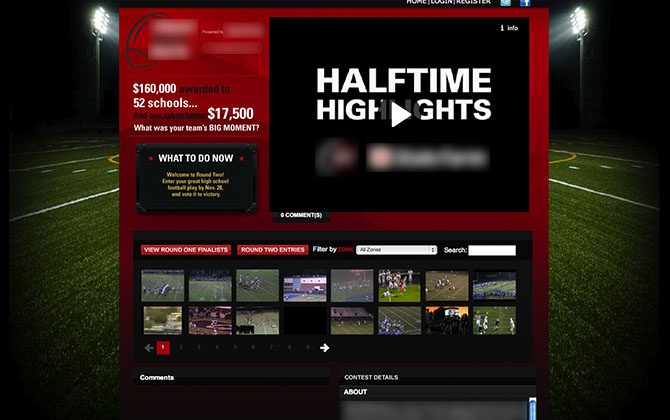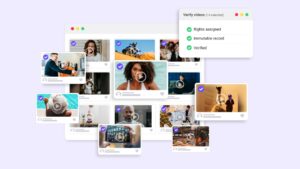In today’s social media-centered world, almost every marketing team has a user-generated content strategy. Or is planning one. This is chiefly because UGC is so effective. Some 91% of consumers say they are more likely to share content about a brand if they see the brand re-sharing customer content.
But the act of repurposing social media is a big chore. You have to find a relatable hashtag that no-one is using, set up and market a competition page, monitor the entries and then somehow download the content. And that’s before you chase consent, reformat the images and put in your branding.
This is why many brands are turning away from purely repurposing content from platforms like Instagram or Facebook and also using video submission tools to build video libraries of customer-submitted video clips.
Requesting videos directly from customers can actually be more effective, cheaper, and more authentic. First of all, customer-submitted videos are more likely to be raw footage, able to be produced by the brand into finished marketing content than influencer-produced content. Secondly, customer videos are usually shorter and more to the point than repurposed videos, making them more valuable to a brand’s market research teams. Finally, customer-submitted videos feel more personal and genuine because they feature real people talking about their real experiences. In an increasingly competitive market, companies that invest in video submission libraries will have a significant advantage.
1. What is UGC and why is it so important for brands?
User-generated content (UGC) is any type of content that has been created and published by someone other than the brand or company. This is typically photographs posted to Instagram, written blog posts or reviews or short form videos posted to Tik Tok, Instagram Stories or Facebook Reels. While UGC can be a great way for brands to connect with their audience, it also has the potential to do serious damage if not managed carefully. In today’s social media-driven world, negative UGC can quickly go viral, resulting in a wave of bad publicity for the brand.
In fact, many major brands are turning away from paid influencers, in favour of brand communities. This takes work from the brand in terms of community engagement, but results in a far richer library of assets from real brand advocates and super users. Many customer advocates like the closed community feel of being a brand insider.
Additionally, customer-submitted content is often more relatable and authentic than UCG or influencer content, making them more effective at driving sales. As a result, brands need to be careful about the UGC they promote and be sure to monitor user-generated content closely. When done correctly, UGC can be an extremely powerful tool for brands. However, when mishandled, it can do serious damage to a brand’s reputation.
2. The difference between repurposing and customer advocacy
There’s a big difference between requesting content from customers and repurposing it. Requesting UGC usually refers to conducting a video contest or asking customers to submit reviews or photos that can be used on your website or social media channels. On the other hand, repurposing UGC means taking someone else’s content and using it in your own marketing materials.
Both requesting and repurposing UGC can be effective ways to engage with your audience and generate customer advocacy. However, it’s important to understand the difference between the two so that you can choose the right approach for your needs. If you’re looking for fresh, original content, requesting UGC is the way to go. But if you want to save time and resources, repurposing UGC may be a better option.
Repurposing is the process of taking existing content and using it in a new way. This could involve changing the format of the content, or simply using it in a new context. For example, a blog post could be repurposed as an infographic, or a series of tweets could be compiled into an article. Requesting UGC, on the other hand, is explicitly asking users to create new content. This is often done as part of a contest or promotion, but it can also be part of a customer advocacy or engagement strategy. By requesting UGC, brands can tap into the creativity of their fans and followers, and generate fresh content at the same time.
As most brands have found, repurposing social media is a big chore. Most big brands have specialist digital marketing teams whose days are all about chasing down and managing UGC. First you have to find a hashtag that no-one is using, set up and market a competition page, monitor the entries and then somehow download the content. And that’s before you chase consent, reformat the images and put in your branding.
Another problem with repurposing is that there is relatively little video content that can be re-used beyond sharing and liking on the native social media platform on which it sits. So sharing a cute TikTok or an on-brand Reel is one thing. Trying to download and re-use that video in other contexts is another. Most video is shot in portrait, which makes it hard to use in Facebook or YouTube content. Also, most video clips have filters, stickers and other visual pollution over the screen. Finally, downloading video from these platforms is actually against their terms of service. What’s more, the uploader owns the copyright on all content they post, shared with the platform in most cases.
Directly requesting videos from your brand advocates ensure not only authenticity, but a much broader reach. Plus with video contest platforms out there to handle consent and formatting, you never have to worry about legal issues again.
3. How to request UGC from your customers
Requesting user-generated videos from your customers is a great way to increase customer engagement and advocacy. A video contest is a great way to get customers involved and requesting user-generated videos helps to create a sense of community and ownership.
Furthermore, requesting user-generated videos also allows you to collect valuable customer feedback that can be used to improve your product or service. Another option is to request customer advocacy videos. This can be done by asking customers to record a short video testimonial or review.
When requesting user-generated videos from your customers, be sure to clearly state the contest rules and prize details. This will help to ensure that only quality videos are submitted and that the contest is fair for all participants.
Finally, make sure to promote the contest widely so that as many customers as possible have the chance to participate. By following these simple tips, you can requesting user-generated videos from your customers in a way that is both effective and fun.
If you use a video submission management platform like Vloggi, you can use social media platforms to request user-generated video. This can be done by posting a call-to-action on your company’s social media channels with the upload link to encourage customers to submit their own videos. No matter which method you choose, requesting user-generated video is a great way to increase customer engagement and build brand awareness.
4. Examples of brands that are killing it with video contests
There are a number of brands that are doing a great job with video contests. A key element of their success is requesting video content from customers. This helps to increase customer advocacy and engagement. And, of course, it also means that they have a ready supply of great video content to use in their marketing initiatives. Some of the brands that are really killing it with video contests include GoPro (who even now have annual award shows, due to the quality of video submissions), Nikon, and Virgin Mobile USA. Each of these companies has been able to use video contests to generate a ton of excitement and engagement. And, most importantly, they’ve been able to use the videos they’ve received to create some truly incredible marketing campaigns.

Requesting user-generated content in the form of a video contest is a great way to increase customer engagement and advocacy. Not only does it give your customers a chance to show off their creativity, but it also helps to build a sense of community around your brand. Many visual technology companies (such as GoPro, Canon, Apple etc) regularly host contest requesting videos that showcase their products in action. The winners of these contests receive prizes that range from free products to cash prizes. As a result, not only are these companies able to increase customer engagement, but they’re also able to generate a ton of user-generated content that can be used in future marketing campaigns.

However, other, less obvious companies also leverage customer video contests. A top-tier US insurance company runs an annual video contest for high school students around the United States upload videos of their football team’s best play during a game or practice. Teams uploaded videos and through sets of phased voting, participants voted on their favorite to advance to the finals and win the contest. The insurance company then allows schools to use the videos in their own communications, with the insurance company logo attached. The company does not seek to make commercial gain out of the content, but rather provide community tools to help its corporate social responsibility. The contests also provide lead generation and market research.

Read how Australian tire retailer JAX Tyres uses video contests to penetrate lucrative new market verticals
5. The benefits of customer advocacy videos over other forms of content marketing
There are many benefits to requesting customer videos via a contest over other forms of content marketing:
First, video contests are an excellent way to get customers involved and engaged with your brand.
Second, video contests help create customer Advocates who can speak positively about your products or services.
Third, video contests are a great way to generate fresh and original content.
Finally, video contests can be a great marketing tool, helping to increase brand awareness and reach a wider audience. Overall, video contests offer a number of advantages and should be seriously considered as part of any content marketing strategy.
Video contests have the advantage of giving you more control over the content and ensuring that it meets your standards. However, it can be more expensive and time-consuming to produce high-quality videos from the raw footage, unless you use a platform like Vloggi where editing and compilation tools are built right into the tool.
[sc_fs_faq html=”true” headline=”h2″ img=”6463″ question=”What are some examples of customer video submissions?” img_alt=”” css_class=””] Ultimately, it comes down to what is right for your business. It depends if you are a product or a service. However, at Vloggi, some of the most popular use cases for video submissions are: Video testimonials, product demonstrations, video tutorials, unboxing videos, vox pops on a topic and product-in-action videos. <br> Product-in-action videos are particularly effective if you have a loyal band of brand ambassadors. These are the kind of people who already make content and post on their own social media. By running a video contest through a direct submission platform like Vloggi, you are automatically gaining the copyright and ability to re-use in your campaigns. [/sc_fs_faq]
6. How to get started with requesting customer video submissions
Requesting video from your customers is easier than you think. You can start by hosting a video contest. This is a great way to engage your customers and get them talking about your brand. You can also request videos as part of a customer advocacy program. This is an excellent way to get positive reviews and testimonials that you can use in your marketing campaigns. Finally, you can simply ask your customers to submit videos about their experience with your product or service. This is a great way to get honest feedback and create user-generated content that you can use on your website or social media channels.
When it comes to requesting video from your customers, there are a few things to keep in mind.
- First, you’ll want to make sure that your video request is clear and concise. Customers should understand exactly what you’re asking for, and why you’re requesting it.
- Secondly, you may want to consider running a video contest. This can be a great way to engage your customers and get them excited about creating videos for your brand.
- Finally, don’t forget about customer advocacy. Getting customers involved in creating and sharing videos is a great way to create positive buzz for your brand.
These are just a few things to keep in mind when requesting video from your customers. By following these tips, you’ll be on your way to creating great video content that will helpengage and connect with your audience.
There are pros and cons to both user-generated videos and direct submissions. It really depends on the goals of the business and what type of content they are looking for.
User-generated videos can be a great way to connect with customers and create a sense of community around your brand. They can also be less expensive and time-consuming to produce than traditional marketing videos. However, you may have less control over the quality of the content and it may be harder to ensure that your message is getting across.
Direct submissions can give you more control over the quality of the content, but they may be more expensive and time-consuming to produce. You will also need to carefully consider how you select which videos to feature, as you want to avoid coming across as too promotional.
Read more on how to incentivize your community to participate in your video submission marketing campaign






